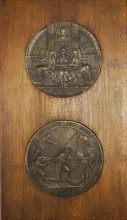Emil Fuchs
Emil Fuchs (1866-1929) was an Austrian artist and teacher at the Royal Academy in London, Paris, Berlin, Munich, Vienna, and Rome. He was a sculptor, medallist, and painter who studied at the Akademie der Bildenden Künste, Vienna, and at the Berlin Akademie. He travelled to Rome before settling in London in 1897, exhibiting at the Royal Academy the following yearFuchs sculptural oeuvre consists of large groups, portrait busts, statuettes and memorials in marble, bronze and silver. The bronze statue La pensierosa (New York, Met.) is a good example of his contemplative style, as is the marble Mother-love (exh. London, RA, 1898) of his liking for melodramatic allegory. His memorials include The Sisters (marble; Liverpool, Walker A.G.). Most of his paintings are portraits, done in a flashy style that owes much to his friend John Singer Sargent (e.g. Sir Joseph Duveen, 1903; London, Tate). Both his painted and sculpted portraits were immensely fashionable in Britain at the turn of the century and Fuchs was taken up by the royal family, modelling a number of medals that were struck for Queen Victoria that portrayed Princess Alexandra as the Princess of Pity (silver, 1900; London, BM) and executing a coronation medal for Edward VII (silver and bronze, 1902). He brought to the British medal the soft-edged decorative style that was then popular in the Austria to which he always remained faithful. He designed the postage stamps of Edward VIAfter World War I, Fuchs moved to New York, where he continued working up until his suicide.
